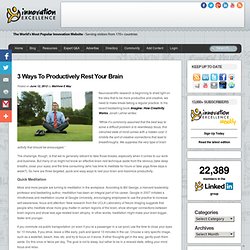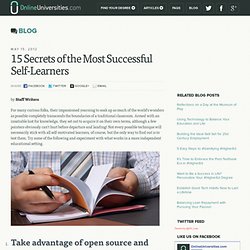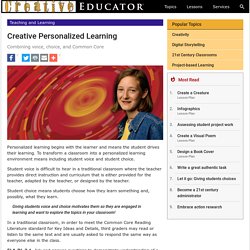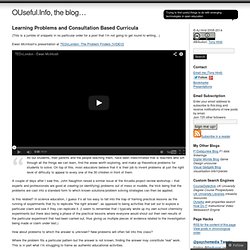

Jeff Sturges, Ignite Talk Saturday. Alistair smith learning. Scientists Find Learning Is Not 'Hard-Wired' 3 Ways To Productively Rest Your Brain. Neuroscientific research is beginning to shed light on the idea that to be more productive and creative, we need to make break-taking a regular practice.

In his recent bestselling book Imagine: How Creativity Works, Jonah Lehrer writes: “While it’s commonly assumed that the best way to solve a difficult problem is to relentlessly focus, this clenched state of mind comes with a hidden cost: it inhibits the sort of creative connections that lead to breakthroughs. We suppress the very type of brain activity that should be encouraged.” 15 Secrets of the Most Successful Self-Learners. For many curious folks, their impassioned yearning to soak up as much of the world’s wonders as possible completely transcends the boundaries of a traditional classroom.

Armed with an insatiable lust for knowledge, they set out to acquire it on their own terms, although a few pointers obviously can’t hurt before departure and landing! Not every possible technique will necessarily stick with all self-motivated learners, of course, but the only way to find out is to test them. Try some of the following and experiment with what works in a more independent educational setting. Take advantage of open source and coursewareLearn for free via resources like iTunes U, YouTube EDU, Open Culture, MIT Open Courseware, and many, many more examples of open source and courseware. These free (or low-cost, in some cases) offerings provide everything from overviews to entire classes for self-motivated learners wanting to pick up pretty much any subject imaginable.
Sowing Failure, Reaping Success: What Failure Can Teach. Mark Humphrey/Associated PressBill Belichick, coach of the New England Patriots, moments before losing to the Giants, 21-17, in Super Bowl XLVI in February.

When Have You Ever Failed at Something? What Happened as a Result? We pose these questions for students to answer as part of thinking about the broad theme of “failure”: how it is defined, what it means and what it can lead to. Everyone grapples with failure, even (or maybe especially) tremendously successful people. Reinventing Education To Teach Creativity And Entrepreneurship.
As you read this, students all over the country are sitting for state standardized exams.

Schools spend up to 40% of the year on test prep, so that, shall we say, no child is left behind. Schools’ futures and funding depend on the number of students who fall into performance bands like "Advanced," "Proficient," and "Approaching Basic" based on bubble sheets and number two pencils. But this is not the rant you think it is. BlogPost Progress Report: peer assessment. Over the last four semesters, beginning in the spring of 2011, I have been using a badge system that allows for peer review and the awarding of badges that can then be shared on the open badge infrastructure.

Being bilingual 'boosts brain power' 1 May 2012Last updated at 02:49 ET Differences were seen in the brainstem (coloured orange in this picture) Learning a second language can boost brain power, scientists believe.

The US researchers from Northwestern University say bilingualism is a form of brain training - a mental "work out" that fine-tunes the mind. Speaking two languages profoundly affects the brain and changes how the nervous system responds to sound, lab tests revealed. Experts say the work in Proceedings of the National Academy of Sciences provides "biological" evidence of this. For the study, the team monitored the brain responses of 48 healthy student volunteers - which included 23 who were bilingual - to different sounds. Creative Personalized Learning. Combining voice, choice, and Common Core Personalized learning begins with the learner and means the student drives their learning.

To transform a classroom into a personalized learning environment means including student voice and student choice. Prof. Guy Claxton talks to GEMS Parents at GEMS Wellington International School, Dubai. Gaining Some Perspective on Badges for Lifelong Learning. 9 Essential Skills Kids Should Learn, by Leo Babauta. Two questions that can change your life. Bloom's Digital Taxonomy. What’s Blended Learning? Ask Salman Khan.
Dr. Michio Kaku: The Problem with the learning system in school. Empowering Young Learners. Creativity. School Leadership. LTS:metacognition. Prof Stephen Heppell. Are You Left or Right Brain? Learning Problems and Consultation Based Curricula. (This is a jumble of snippets in no particular order for a post that I’m not going to get round to writing…) Ewan McIntosh’s presentation at TEDxLondon: The Problem Finders [VIDEO] All our students, their parents and the people teaching them, have been indoctrinated that is teachers who sift through all the things we can learn, find the areas worth exploring, and make up theoretical problems for students to solve.

On top of this, most educators believe that it is their job to invent problems at just the right level of difficulty to appeal to every one of the 30 children in front of them. A couple of days after I saw this, John Naughton raised a similar issue at the Arcadia project review workshop – that experts and professionals are good at creating (or identifying) problems out of mess or muddle, the trick being that the problems are cast into a standard form to which known solutions/problem solving strategies can then be applied. Is this related? PS maybe related? Do Learning Styles Really Exist? Do learning styles exist?

Let me answer that by saying, most definitely ‘yes’.